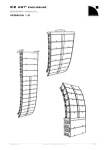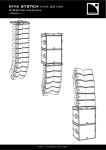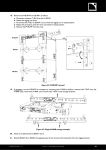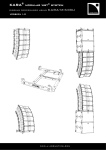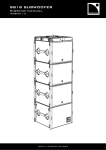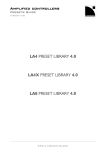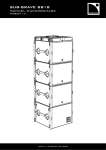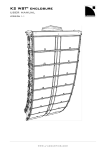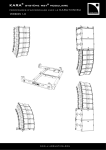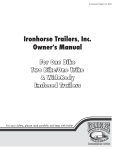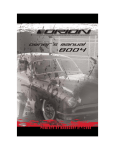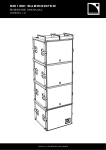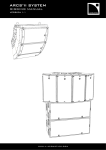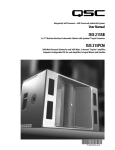Download K2 rigging manual - Scandec Systemer
Transcript
K2 WST enclosure ® RIGGING MANUAL VERSION 3.0 K2_RM_EN_3.0 www.l-acoustics.com 1 / 76 K2 WST® enclosure RIGGING MANUAL VERSION 3.0 SAFETY INSTRUCTIONS 1. Read this manual 2. Follow all SAFETY INSTRUCTIONS as well as DANGER and OBLIGATION warnings 3. Never incorporate equipment or accessories not approved by L-ACOUSTICS® 4. Read all the related PRODUCT INFORMATION documents before exploiting the system The product information document is included in the shipping carton of the related system component. 5. Work with qualified personnel for rigging the system Installation should only be carried out by qualified personnel that are familiar with the rigging techniques and safety recommendations outlined in this manual. 6. Ensure personnel health and safety During installation and set-up personnel must wear protective headgear and footwear at all times. Under no circumstances personnel is allowed to climb on a loudspeaker assembly. 7. Respect the Working Load Limit (WLL) of third party equipment L-ACOUSTICS® is not responsible for any rigging equipment and accessories provided by third party manufacturers. Verify that the Working Load Limit (WLL) of the suspension points, chain hoists and all additional hardware rigging accessories is respected. 8. Respect the maximum configurations and the recommended safety level For safety issue, respect the maximum configurations outlined in this manual. To check the conformity of any configuration in regards with the safety level recommended by L-ACOUSTICS®, model the system in SOUNDVISION and refer to the warnings in Mechanical Data section. 9. Be cautious when flying a loudspeaker array Always verify that no one is standing underneath the loudspeaker array when it is being raised. As the array is being raised, check each individual element to make sure that it is securely fastened to the adjacent element. Never leave the array unattended during the installation process. As a general rule, L-ACOUSTICS® recommends the use of safety slings at all times. 10. Be cautious when ground-stacking a loudspeaker array Do not stack the loudspeaker array on unstable ground or surface. If the array is stacked on a structure, platform, or stage, always check that the latter can support the total weight of the array. As a general rule, L-ACOUSTICS® recommends the use of safety straps at all times. 11. Take into account the wind effects on dynamic load When a loudspeaker assembly is deployed in an open air environment, wind can produce dynamic stress to the rigging components and suspension points. If the wind force exceeds 6 bft (Beaufort scale), lower down and/or secure the loudspeaker array. SYMBOLS The following symbols are used in this document: DANGER This symbol indicates a potential risk of harm to an individual or damage to the product. It can also notify the user about instructions that must be strictly followed to ensure safe installation or operation of the product. OBLIGATION This symbol notifies the user about instructions that must be strictly followed to ensure proper installation or operation of the product. EQUIPMENT This symbol indicates the equipment, tools, and spare parts required to perform a procedure. INFORMATION This symbol notifies the user about complementary information or optional instructions. K2_RM_EN_3.0 www.l-acoustics.com 2 / 76 WELCOME TO L-ACOUSTICS® Thank you for choosing the L-ACOUSTICS® K2 WST® system. This document contains essential information on rigging the system properly and safely. Carefully read this document in order to become familiar with these procedures. As part of a continuous evolution of techniques and standards, L-ACOUSTICS® reserves the right to change the specifications of its products and the content of its documents without prior notice. Please check the L-ACOUSTICS® web site on a regular basis to download the latest document and software updates: www.l-acoustics.com. K2 WST® SYSTEM The L-ACOUSTICS® K1 system has achieved international recognition and is today the prime choice of engineers for the largest stadium tours and outdoor festivals. Its sonic performance, its fully integrated system package and its rider friendliness are considered as the industry benchmarks. With K2, L-ACOUSTICS® offers K1 performance in a rescaled package. The K2 system flexibility makes it suited to both permanent installation and touring applications, from theatre to stadium productions. The main system components are as follows: • • • • K2, full-range element, with adjustable horizontal directivity, operating from 35 Hz to 20 kHz K1-SB, low-frequency element, reinforcing LF contour down to 30 Hz or LF throw down to 35 Hz SB28, low-frequency element, extending the operating bandwidth down to 25 Hz LA4X/LA8 amplified controllers or LA-RAK, touring rack fitted with three LA8 The 3-way quad amplified design, the transducers resources are among the characteristics giving K2 an exceptional ability to perform in many applications and with a record-breaking performance/weight ratio. Any on-site deployment can be easily and quickly achieved thanks to an extremely ergonomic, fast and captive rigging system. A K2 line source utilizes the unrivalled characteristics of Wavefront Sculpture Technology®. Inter-element angles can be set with laser like accuracy up to a generous 10˚, allowing the optimization of the vertical coverage with SPL smoothly spread across the audience. Horizontally, the K2 coverage pattern can be adjusted to sector and match any audience or specific room geometries. Four different settings are possible: two symmetric (70° or 110°) and two asymmetric (90° as 35°/55° or 55°/35°). Thanks to its full range capability, the K2 enclosure can be deployed as a standalone line source. For applications demanding extreme LF impact (contour mode), or maximized LF projection (throw mode), K2 can be arrayed with its dedicated and flyable K1-SB LF extension. The K2 system can also address applications with demanding infrasonic reproduction when combined to the SB28 subwoofer. Before installation, any system configurations can be acoustically and mechanically modeled with SOUNDVISION 3D simulation software. For touring applications, K2 can be associated to the LA-RAK, a universal distribution platform for power, audio signals and network which facilitates cross rental between rental companies. LA-RAK houses three LA8 amplified controllers and can be flown onto a K2 array. Other applications can feature LA8 amplified controllers. For high-end installation projects, K2 can also be driven by the LA4X amplified controller. The scheme authorizes fully discrete DSP treatment per section and maximum power headroom for the best possible sonic performance. Thanks to dedicated factory presets, the LA8/LA4X amplified controller constitutes an extremely advanced and precise drive system for the enclosures. All L-ACOUSTICS® amplified controllers feature the L-DRIVE, a thermal and overexcursion protection circuit. Up to 253 LA8/LA4X amplified controllers can be connected together via the Ethernet-based L-NET protocol. The LA NETWORK MANAGER software allows online remote control and monitoring of all the connected units, via a userfriendly and intuitive graphic interface, and features the Array Morphing EQ. This exclusive tool allows the engineer to quickly adjust the tonal balance of the system to reach a reference curve or to ensure consistency of the sonic signature. K2_RM_EN_3.0 www.l-acoustics.com 3 / 76 K2 WST® enclosure RIGGING MANUAL VERSION 3.0 CONTENTS 1 K2 RIGGING SYSTEM 1.1 Loudspeaker enclosure ............................................................................................................................................................... 6 6 1.2 Rigging elements.......................................................................................................................................................................... 6 1.3 Software application .................................................................................................................................................................... 6 1.4 Transportation and storage accessories ...................................................................................................................................... 6 2 MECHANICAL SAFETY 2.1 Mechanical limits ......................................................................................................................................................................... 8 2.2 Assessing mechanical safety ......................................................................................................................................................... 9 3 RIGGING SYSTEM DESCRIPTION 3.1 Elements for enclosure rigging .................................................................................................................................................. 10 3.2 Elements for storage and transportation ................................................................................................................................... 11 3.3 Elements for ground-stacking .................................................................................................................................................... 12 3.4 Elements for flying ..................................................................................................................................................................... 13 3.5 Elements for LA-RAK rigging ..................................................................................................................................................... 16 4 SYSTEM SETUP 4.1 Ground-stacking ........................................................................................................................................................................ 18 8 10 18 K2 enclosures on K2-CHARIOT and K2-JACK ........................................................................................................................ 18 K2 enclosures on K1-SB ........................................................................................................................................................... 18 4.2 Flying ............................................................................................................................................................................ 19 K2 enclosures under K2-BUMP ............................................................................................................................................... 19 K2 enclosures under K2-RIGBAR ............................................................................................................................................. 20 K2 enclosures under K1 system elements ................................................................................................................................ 21 5 SUBSET PROCEDURES 22 Preparing a block of 4 K2 .................................................................................................................................... 22 Preset the inter-enclosure angles ........................................................................................................................ 24 Attaching K2-JACK stabilizers to a K2-CHARIOT ............................................................................................... 25 Changing the position of the K2-CHARIOT rear rigging arm .............................................................................. 29 Adjusting the K2-CHARIOT site angle ................................................................................................................ 32 Stacking K2 on K2-BUMP .................................................................................................................................... 33 Attaching K2-BAR on K2-BUMP ......................................................................................................................... 36 Attaching a block of four K2 under K2-BUMP .................................................................................................... 38 Attaching a block of four K2 under K2-RIGBAR .................................................................................................. 40 Attaching a block of four K2 under K2 ................................................................................................................ 42 Attaching a block of four K2 under a K1 system element ................................................................................... 46 Attaching K1 or K1-SB under K2-BUMP ............................................................................................................. 51 Stacking LA-RAK on K2-BUMP ........................................................................................................................... 52 Using a K2-RIGBAR to implement a pullback ...................................................................................................... 56 K2_RM_EN_3.0 www.l-acoustics.com 4 / 76 APPENDIX A: PICKUP POINTS GUIDELINES 58 K2-BUMP with LA-RAK ........................................................................................................................................................................ 58 K2-BUMP with no LA-RAK ................................................................................................................................................................... 60 K1-DELTA for azimuth control ............................................................................................................................................................. 61 APPENDIX B: INSTALLING A LASER INCLINOMETER 62 TEQSAS® LAP-TEQ ............................................................................................................................................................................ 62 SSE PROSIGHT ............................................................................................................................................................................ 63 K2-LASERMOUNT ............................................................................................................................................................................ 64 APPENDIX C: SPECIFICATIONS 67 K2 ............................................................................................................................................................................ 67 K1-SB ............................................................................................................................................................................ 68 SB28 ............................................................................................................................................................................ 69 K2-BUMP ............................................................................................................................................................................ 70 K2-BUMP-FLIGHT ............................................................................................................................................................................ 70 K2-BAR ............................................................................................................................................................................ 71 K2-LINK ............................................................................................................................................................................ 71 K2-RACKMOUNT ............................................................................................................................................................................ 72 K1-DELTA ............................................................................................................................................................................ 73 LA-SLING2T ............................................................................................................................................................................ 73 K2-RIGBAR ............................................................................................................................................................................ 74 K2-CHARIOT ............................................................................................................................................................................ 75 K2-JACK ............................................................................................................................................................................ 75 K2_RM_EN_3.0 www.l-acoustics.com 5 / 76 K2 WST® enclosure RIGGING MANUAL VERSION 3.0 1 K2 RIGGING SYSTEM The system approach developed by L-ACOUSTICS® consists in providing packaged solutions for loudspeaker systems in order to guarantee the highest and most predictable level of performance at any step: modeling, installation, and operation. An L-ACOUSTICS® loudspeaker system is the set of components available to form any loudspeaker system based on one of the full-range loudspeaker enclosures afforded by L-ACOUSTICS®. It includes enclosures, rigging accessories, loudspeaker cables, amplified controllers and software applications. The main components involved in the rigging process of a K2 system are the following: 1.1 Loudspeaker enclosure K2 Full range enclosure, deployable in a variable curvature line source. K1-SB Dedicated subwoofer enclosure, deployable with K2. 1.2 Rigging elements K2-CHARIOT Transport dolly for four K2 enclosures. K2-JACK Tilt adjustment screw jacks and bar for K2-CHARIOT K2-BUMP Rigging frame used to fly K2 line arrays. Designed to be compatible with K1 and K1-SB. Provided with two bow shackles WLL 3.25 t. K2-BAR Rigging bar designed to provide a wider range of site angles for the K2-BUMP. Provided with two bow shackles WLL 3.25 t. K1-DELTA Rigging plate designed to be used optionally with the K2-BUMP, to adjust the azimuth angle of flown K2 / K1 / K1-SB arrays. K2-BUMPFLIGHT Flight-case dedicated to the rigging elements of the K2 system. In order to be used as storage for the K2-BUMP it must be prepared using the foams provided with the product. K2-LINK Rigging interface between K2 and K1 or K1-SB. K2-RACKMOUNT Rigging interface for stacking one or two LA-RAK on top of a K2 array flown with a K2BUMP. K1-BPCHAIN Adjustable sling used to prevent the chain bag of a climbing hoist being in front of a flown array top enclosure. LA-SLING2T Chain sling with two-leg bridles used to implement bridle hangs. K2-RIGBAR Light rigging bar and pullback accessory (incl. LA-SLING2T). 1.3 Software application SOUNDVISION 1.4 Proprietary 3D acoustical and mechanical modeling software. Transportation and storage accessories K2-CHARIOTCOV Protective cover for transportation and storage Other K2 SYSTEM components All the other components of the system are presented in the K2 user manual, document intended to describe the enclosure configurations and connection scheme. K2_RM_EN_3.0 www.l-acoustics.com 6 / 76 K2 K1-SB LA-RAK K2-BUMP K2-RACKMOUNT K2-BAR K2-LINK K2-JACK K1-DELTA K2-CHARIOT K2-RIGBAR K1-BPCHAIN LA-SLING2T SOUNDVISION Main components involved in the K2 rigging process K2_RM_EN_3.0 www.l-acoustics.com 7 / 76 K2 WST® enclosure RIGGING MANUAL VERSION 3.0 2 MECHANICAL SAFETY 2.1 Mechanical limits The K2 rigging system complies with 2006/42/EC: Machinery Directive. It has been designed following the guidelines of BGV-C1. 2006/42/EC: Machinery Directive specifies a safety factor of 4:1 against the rupture. The limits specified in the tables below correspond to a safety factor of 4:1 or higher for flown deployments. Refer to SOUNDVISION for the safety factor of a specific deployment. The safe limit gives the maximum number of elements for which the safety factor is always compliant with the 2006/42/EC: Machinery Directive, regardless of the other deployment parameters (site angles, inter-enclosure angles, etc.). The maximum limit gives the maximum number of elements for which the safety factor can be compliant with the 2006/42/EC: Machinery Directive, when the other deployment parameters provide the best mechanical conditions. Ground-stacked Safe limit Maximum limit K2-BUMP or K2-CHARIOT with K2-JACK 4 K2 6 K2 Flown Safe limit Maximum limit 16 K2 14 K2 + 2 LA-RAK 24 K2 24 K2 + 2 LA-RAK 12 K1-SB + 1 LA-RAK 16 K1-SB + 2 LA-RAK 16 K2 24 K2 K2-BUMP K2-BUMP + K2-BAR K2-LINK under K1-BUMP K2-RIGBAR 12 K2 SOUNDVISION and mechanical safety To deploy more elements than the safe limits, or when mixing different type of loudspeaker enclosures within the same array, always model the system in SOUNDVISION before installation, and check the Mechanical Data section for any stress warning or stability warning. K2_RM_EN_3.0 www.l-acoustics.com 8 / 76 2.2 Assessing mechanical safety In order to assess the actual safety of any array configuration before implementation, refer to the following warnings: Rated working load limit (WLL) is not enough The rated WLL is an indication of the element resistance to tensile stress. For complex mechanical systems such as loudspeaker arrays, WLLs cannot be used per se to determine the maximum number of enclosures within an array or to assess the safety of a specific array configuration. Mechanical modeling with SOUNDVISION The working load applied to each linking point, along with the corresponding safety factor, will depend on numerous variables linked to the composition of the array (type and number of enclosures, splay angles) and the implementation of the flying or stacking structure (number and location of flying points, site angle). This cannot be determined without the complex mechanical modeling and calculation offered by SOUNDVISION Assessing the safety with SOUNDVISION The overall safety factor of a specific mechanical configuration always corresponds to the lowest safety factor among all the linking points. Always model the system configuration with the SOUNDVISION software and check the Mechanical Data section to identify the weakest link and its corresponding working load. By default, a stress warning will appear when the mechanical safety goes beyond the recommended safety level. Safety of ground-stacked arrays in SOUNDVISION For ground-stacked arrays, a distinct stability warning is implemented in SOUNDVISION. It indicates a tipping hazard when the array is not secured to the ground, stage or platform. It is user responsibility to secure the array and to ignore this warning. Consideration must be given to unusual conditions SOUNDVISION calculations are based on usual environmental conditions. A higher safety factor is recommended with factors such as extreme high or low temperatures, strong wind, prolonged exposition to salt water, etc. Always consult a rigging specialist to adopt safety practices adapted to such a situation. K2_RM_EN_3.0 www.l-acoustics.com 9 / 76 K2 WST® enclosure RIGGING MANUAL VERSION 3.0 3 RIGGING SYSTEM DESCRIPTION K2 enclosures can be ground-stacked and flown independently (K2-BUMP) or in combination with K1 system elements (K1, K1-SB, or K1-BUMP). The K2-BUMP is designed to be directly compatible with K1 and K1-SB. The K2 enclosure rigging system requires the K2-LINK interface to be compatible with the K1 rigging system. 3.1 Elements for enclosure rigging On both sides, the K2 enclosure integrates two arms to connect to another element of the rigging system, such as an enclosure or to a flying frame. At the front, a rotating arm provides a fixed point around which the enclosure can freely rotate until its connection at the rear. At the rear, a sliding arm allows the inter-element angle setting and the inter-element rear connection. The angles between adjacent enclosures are secured by an automatic system that is activated in advance and locks itself during the stacking and lifting procedures. K2_RM_EN_3.0 www.l-acoustics.com 1 0 / 76 3.2 Elements for storage and transportation The K2-CHARIOT is designed for the transportation and storage of blocks of four K2 enclosures. During transportation the blocks must have an inter-enclosure angle of 10° to avoid any separation of the enclosures. This angle must be set using the enclosure rear rigging arm pin. The automatic locking system must remain unloaded. The K2-CHARIOT rear rigging arm must be at its -15° site angle position. TIPPING HAZARD If the enclosures are not pinned at 10°, they can separate at the back, causing the stack to tip over. K2_RM_EN_3.0 www.l-acoustics.com 1 1 / 76 K2 WST® enclosure RIGGING MANUAL VERSION 3.0 3.3 Elements for ground-stacking The K2-CHARIOT, combined with two K2-JACK stabilizers, is used as a stacking platform for K2 enclosures. TIPPING HAZARD Always install the K2-JACK stabilizers before: - setting the inter-enclosure angles - changing the position of the K2-CHARIOT rear rigging arms K2_RM_EN_3.0 www.l-acoustics.com 1 2 / 76 3.4 Elements for flying The K2-BUMP is designed for flying line arrays of K2, K1 or K1-SB enclosures. 4 holes are available on the central bar of the K2-BUMP. Refer to your SOUNDVISION model to know which holes to use. With K1-SB and a single motor the hole no 2 provides a 0° site angle. By adding a K2-BAR to the K2-BUMP, the site angle range can be increased. 21 holes are available on the K2-BAR which can be attached to the K2-BUMP as a rear or a front extension and in position A or B, thus offering a total of 84 discrete positions for pick-up points. The rear extension is suited to downwards and front extension to upwards site angles. K2_RM_EN_3.0 www.l-acoustics.com 1 3 / 76 K2 WST® enclosure RIGGING MANUAL VERSION 3.0 Standard: One K2-BAR attached in the center of K2-BUMP Alternative: Two K2-BAR attached on the sides The K2-LINK is designed as an interface between the K1 and K2 rigging systems. It is used to hand K2 under K1, K1-SB or K1-BUMP. It provides three holes and therefore three angles between the top K2 enclosure and the bottom K1 element: 0.25°, 2.5° and 5°. K2_RM_EN_3.0 www.l-acoustics.com 1 4 / 76 The K2-RIGBAR can be used to implement a pullback The K2-RIGBAR can also be used as the main lifting either with K2-BUMP / K2-BAR or another K2-RIGBAR. point, thus providing a lighter solution for flying K2 enclosures with one lifting point. It must be used with the LA-SLING2T. Refer to PROCEDURE N for more information on how to implement a pullback. K2_RM_EN_3.0 www.l-acoustics.com 1 5 / 76 K2 WST® enclosure RIGGING MANUAL VERSION 3.0 3.5 Elements for LA-RAK rigging The K2-RACKMOUNT is designed to stack one or two LA-RAK on top of a flown array. It is composed of four rails and a stabilizer. The rails are screwed on the K2-BUMP. Their number and position depend on the number of racks. The K2-RACKMOUNT must be used along with either one or two K2-BAR. 1 LA-RAK : 2 rails : 2 K2-BAR K2_RM_EN_3.0 2 LA-RAK : 4 rails : 1 K2-BAR www.l-acoustics.com 1 6 / 76 When two racks are mounted side by side, the stabilizer is used to prevent the assembly from tipping or toppling over. The stabilizer traps one of the chains used to lift the assembly. 0° site angle K2_RM_EN_3.0 30° positive site angle www.l-acoustics.com 1 7 / 76 K2 WST® enclosure RIGGING MANUAL VERSION 3.0 4 SYSTEM SETUP 4.1 Ground-stacking Final check After the setup, always verify no yellow labels are visible on the front and on both sides of the array. K2 enclosures on K2-CHARIOT and K2-JACK Place a block of four K2 enclosures at the final position. If a block is not already built, refer to PROCEDURE A. Preset the inter-enclosure angles. Refer to PROCEDURE B. Attach the K2-JACK stabilizers to the K2-CHARIOT. Refer to PROCEDURE C. If needed, add one or two K2 enclosures to the stack. Refer to PROCEDURE A. Preset the inter-enclosure angles for the additional enclosures. Refer to PROCEDURE B. Push the topmost enclosure forward until all the automatic locks are in place and verify that there is no yellow label visible. If necessary, change the position of the K2-CHARIOT rear rigging arm. Refer to PROCEDURE D. If necessary, fine-tune the site angle of the stack by adjusting the height of the stabilizers feet. Refer to PROCEDURE E. K2 enclosures on K1-SB Stack as many K1-SB enclosures as necessary. Refer to the K1 rigging manual to set up the K1-SB part of the array. Position and attach a K2-BUMP on the K1-SB stack Refer to PROCEDURE L. Position and attach an upside down K2 on the K2-BUMP and add as many K2 enclosures on top of the first one. Refer to PROCEDURE C. K2_RM_EN_3.0 www.l-acoustics.com 1 8 / 76 4.2 Flying Final check After the setup, always verify no yellow labels are visible on the front and on both sides of the array. At least one motor for each K2-BAR When using two K2-BAR, do not implement a bridle between the bars. Nobody behind the array when lifting enclosures. To avoid collisions caused by the swinging motion, do not stand behind the array when lifting the enclosures. Safe maximum of 12 K2 enclosures in a pullback configuration Up to 12 K2. Space between pullback rigging points The space between the two lifting points used for this configuration must be aligned with the array pickup points. The deployment load-bearing lines must be parallel to each other. Before setup, choose a flying option Refer to SOUNDVISION modeling and to 3.4 Elements for flying (p. 13). To implement a pullback with a K2-BAR : in front extension attach the shackle to hole #1. in rear extension attach the shackle to hole #21. K2 enclosures under K2-BUMP Prepare all the blocks of 4 K2 necessary to build the array. If a block is not already built, refer to PROCEDURE A. Preset the inter-enclosures angles. Refer to PROCEDURE B. Place an open a K2-BUMPFLIGHT under the motor. If necessary, attach one or two K2-BAR to the K2-BUMP. Refer to PROCEDURE G. If necessary, stack one or two LA-RAK on the K2-BUMP. Refer to PROCEDURE M. Prepare the pickup points. Refer to SOUNDVISION for the number and position of the shackles. Lift the assembly so you can position a block of four K2 under it. Attach the block of four K2 to the K2-BUMP Refer to PROCEDURE H. Verify that the rear rigging arms are secured by pins and that no yellow label is visible on the front. Lift the assembly so you can position a block of four K2 under it. Verify that no yellow label is visible on both sides of the array. Attach the block of four K2 enclosures to the bottom of the array. Refer to PROCEDURE J. Verify that the rigging arms at the back are secured by pins and that no yellow label is visible on the front. Repeat the two previous steps until the array is complete. If necessary, implement a pullback with K2-RIGBAR. Refer to PROCEDURE N. Raise the array to its final trim height. Adjust site and azimuth angles. K2_RM_EN_3.0 www.l-acoustics.com 1 9 / 76 K2 WST® enclosure RIGGING MANUAL VERSION 3.0 Final check After the setup, always verify no yellow labels are visible on the front and on both sides of the array. Space between lifting points points The space between the two lifting points used for this configuration must be aligned with the array pickup points. The deployment load-bearing lines must be parallel to each other. under K2-RIGBAR under K2-BAR K2 enclosures under K2-RIGBAR Prepare all the blocks of 4 K2 necessary to build the array. If a block is not already built, refer to PROCEDURE A. Preset the inter-enclosures angles. Refer to PROCEDURE B. Attach the K2-RIGBAR on the block of four K2. Refer to PROCEDURE I. Lift the array so you can position another block of four K2 under it. Verify that no yellow label is visible on both sides of the array. Position and attach a block of four K2 enclosures under the array. Refer to PROCEDURE J. Verify that the rigging arms at the back are secured by pins and that no yellow label is visible on the front. Repeat the two previous steps until the array is complete. If necessary, implement a pullback with K2-RIGBAR. Refer to PROCEDURE N. Raise the array to its final trim height. K2_RM_EN_3.0 www.l-acoustics.com 2 0 / 76 Final check After the setup, always verify no yellow labels are visible on the front and on both sides of the array. When using two K2-BAR, do not implement a bridle between the bars. Always use at least two motors Before setup, choose a flying option Refer to SOUNDVISION modeling and to 3.3 Elements for ground-stacking (p. 2). K2 enclosures under K1 system elements K1-SB array setup Refer to your SOUNDVISION model to define which flying frame to use. If you are using the K1-BUMP: Refer to the K1 rigging manual to set up the K1-SB part of the array. Or if you are using the K2-BUMP: Place an open a K2-BUMPFLIGHT under the motor. If necessary, attach one or two K2-BAR to the K2-BUMP. Refer to PROCEDURE G. If necessary, stack one or two LA-RAK on the K2-BUMP. Refer to PROCEDURE M. Prepare the pickup points. Refer to SOUNDVISION for the number and position of shackles. Lift the assembly so you can position a block of K1-SB under it. Attach the K1-SB block to the K2-BUMP. Refer to PROCEDURE L. Repeat the last two steps until the K1-SB array is complete. K2 array setup Prepare all the blocks of 4 K2 necessary to build the array If a block is not built already, refer to PROCEDURE A. Preset the inter-enclosures angles. Refer to PROCEDURE B. K1-SB and K2 arrays connection Lift the K1-SB array so you can position a block of four K2 under it. Using two K2-LINK interfaces, attach the block of K2 under the K1-SB array. Refer to PROCEDURE K. Verify that the rear rigging arms are secured by pins and that no yellow label is visible on the front. Lift the array so you can position a block of four K2 under it. Verify that no yellow label is visible on both sides of the array. Attach the block of four K2 to the bottom enclosure of the array. Refer to PROCEDURE J. Verify that the rear rigging arms are secured by pins and that no yellow label is visible on the front. Repeat the last two steps until the array is complete. Raise the array to its final trim height. Adjust site and azimuth angles. K2_RM_EN_3.0 www.l-acoustics.com 2 1 / 76 K2 WST® enclosure RIGGING MANUAL VERSION 3.0 5 SUBSET PROCEDURES Preparing a block of 4 K2 Minimum staff: 2 1. Attach a K2 enclosure on K2-CHARIOT. Fully rotate the rear rigging arms of the K2-CHARIOT. Position the K2 enclosure on the K2-CHARIOT dolly Lift the rear of the enclosure and rotate the dolly rear rigging arm in its upward position. K2_RM_EN_3.0 Secure the enclosure at the front using the LINK hole. Secure the enclosure using the LINK hole. www.l-acoustics.com 2 2 / 76 2. Attach the other K2 enclosures on top of each other until the block of four is complete. While holding the handle, rotate the front rigging arm and secure it with both LINK pins. Position a K2 enclosure on the first one. Slide the rear rigging arm and secure it with both pins, in the LINK and 10° holes. Keep holding the enclosure in position with the handles until the front rigging arm is secured. 3. Make sure the automatic locking system button is unloaded . If the button has been pressed, pull to disengage the latch K2_RM_EN_3.0 www.l-acoustics.com 2 3 / 76 K2 WST® enclosure RIGGING MANUAL VERSION 3.0 Preset the inter-enclosure angles Minimum staff: 1 On both sides: Remove the pin from its current angle hole Position the pin at the chosen angle hole and slide the rigging arm until the pin goes in. Press the lock button K2_RM_EN_3.0 www.l-acoustics.com 2 4 / 76 Attaching K2-JACK stabilizers to a K2-CHARIOT Minimum staff: 1 K2-JACK stabilizers storage position on K2-CHARIOT K2-JACK stabilizers can be attached to K2-CHARIOT during storage. The K2-JACK stabilizers must not overlap on the wheel stops. They would prevent efficient stacking of K2CHARIOT in storage. K2_RM_EN_3.0 www.l-acoustics.com 2 5 / 76 K2 WST® enclosure RIGGING MANUAL VERSION 3.0 1. Remove the two K2-JACK from the K2-CHARIOT. Remove the stabilizers from each bar Remove the bar from the K2-CHARIOT. K2_RM_EN_3.0 www.l-acoustics.com 2 6 / 76 2. Attach the K2-JACK to the K2-CHARIOT. Insert the K2-JACK studs through the K2-CHARIOT. Raise and turn the K2-JACK handles to secure the locking system. 3. Prepare the K2-JACK stabilizers. Rotate the threaded rod counter-clockwise so the central part of the stabilizer is closest to the base. During the K2-JACK stabilizers first use dust will come off the threaded rod. It is expected and does not indicate a malfunction. K2_RM_EN_3.0 www.l-acoustics.com 2 7 / 76 K2 WST® enclosure RIGGING MANUAL VERSION 3.0 4. Insert the feet in the guides at both ends of the bar. 5. K2_RM_EN_3.0 Attach the stabilzers to the bar. Pivot the feet so they come in contact with the bar. Lock the feet in position by giving a quarter-turn to the locking system. Rotate the feet clockwise to raise the K2-CHARIOT off the ground. www.l-acoustics.com 2 8 / 76 Changing the position of the K2-CHARIOT rear rigging arm Minimum staff: 2 Tipping hazard When the rear rigging arms are unpinned, hold the enclosures on both sides. 1. K2_RM_EN_3.0 On both sides, remove the rear rigging arm pin. www.l-acoustics.com 2 9 / 76 K2 WST® enclosure RIGGING MANUAL VERSION 3.0 2. Change the K2-CHARIOT rear rigging arm position Push the enclosures to free both arms. Use your foot to change the rear rigging arms position. K2_RM_EN_3.0 www.l-acoustics.com 3 0 / 76 3. Secure the enclosures on the K2-CHARIOT. Guide the enclosures back on the arms. Pin the arms. K2_RM_EN_3.0 www.l-acoustics.com 3 1 / 76 K2 WST® enclosure RIGGING MANUAL VERSION 3.0 Adjusting the K2-CHARIOT site angle Minimum staff: 1 1. Verify the wheels are as close as possible to the ground without touching it. 2. Loosen one stabilizer bolt and tighten the other one depending of the target site angle. Do not use a wrench Negative site angle 3. Adjust the site angle: Tipping hazard Adjust either the stabilizer at the front or at the back of the stack. Do not adjust both the front and back of the stack. with the front screw jacks for a positive site angle. 4. Positive site angle with the back screw jacks for a negative site angle. Tighten the front or back bolts depending on the site angle. Do not use a wrench. K2_RM_EN_3.0 www.l-acoustics.com 3 2 / 76 Stacking K2 on K2-BUMP Minimum staff: 2 1. Prepare the K2 block top enclosure. Define the K2 stack site angle with the rear rigging arm. For the top enclosure of the stack, select a value between 0.25 and 7.5 and subtract 3 to obtain the final site angle. Take out and lock the rear and front rigging arms. 2. For the other enclosures, select the angle normally. Turn the enclosure upside down on the K2-BUMP Remove the lower rear and front pins. K2_RM_EN_3.0 www.l-acoustics.com 3 3 / 76 K2 WST® enclosure RIGGING MANUAL VERSION 3.0 3. Attach the K2 enclosure upside down On the K2-BUMP. The rigging arms should rest on the K2-BUMP spacers. Secure the rear arm to the K2-BUMP. On another K2 enclosure. Secure the rear arm to the lower K2 enclosure. Slide the front arm up and down to align the holes and secure it. Attach the front arm to the K2-BUMP Slide the front rigging arm up and down to align the holes. Attach the front arm to the lower K2 enclosure. K2_RM_EN_3.0 www.l-acoustics.com 3 4 / 76


































